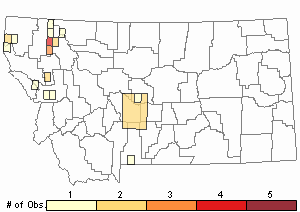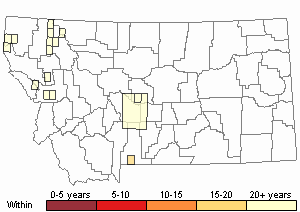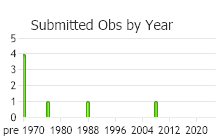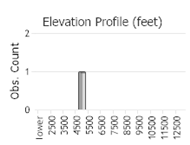View in other NatureServe Network Field Guides
NatureServe
Montana
Utah
Wyoming
Idaho
Wisconsin
British Columbia
South Carolina
Yukon
California
New York
A Lime Moss - Didymodon vinealis
Other Names:
Barbula vinealis
General Description
Plants: Acrocarpous. Growing in clumps of erect shoots (Lawton 1971), green, sometimes deeply so, typically tinged with red (FNA 2007), frequently russet proximally (Lawton 1971). Stems sometimes reaching 20 mm in height, possessing a central strand; hairs of the leaf axil ca 5 cells long, the first 1 or 2 cells brown (FNA 2007).
Leaves: A little bent, curved or twisted, upright and close to the stem to spreading slightly when dry, spreading and sometimes curved back and downward distally when damp, channeled on the ventral surface along the nerve, mostly 0.8-2.5 mm in length, seldom to 4 mm, lance-shaped, tapering to an acute, somewhat keeled, non-deciduous apex; margins smooth, curved back and downward in the proximal half, sometimes to above mid-leaf; costa extending to the leaf tip, and more typically shortly beyond it (FNA 2007).
Leaf Cells: Upper laminal cells isodiametric, smooth or with 2-3 papillae per lumen, usually of 1 cell-layer (sometimes with areas of 2 cell-layers); proximal laminal cells quadrangular (FNA 2007), ca 2-2.5:1 (Lawton 1971), seldom square, the walls fine or only slightly thickened; costa with square or slightly lengthened ventral cells (FNA 2007), in X-section with an abaxial stereid band, a row of 4-5 guide cells, and several rows of cells on the adaxial side of the guide cells (Lawton 1971).
Didymodon vinealis var. vinealis: Present in Montana (FNA 2007).
Didymodon vinealis var. rubiginosus: Present in Montana (FNA 2007).
Phenology
Variety vinealis: Fruit ripens through spring and summer (FNA 2007).
Variety rubiginosus: Fruit ripens in spring (FNA 2007).
Diagnostic Characteristics
Variety vinealis: Some plants have flat margins and very fragile leaf tips (FNA 2007).
Didymodon fallax has a similarly grooved costa, but the superficial ventral cells of its costa are elongate rather than square or nearly so as in D. vinealis (FNA 2007).
Range Comments
Didymodon vinealis: Known in Montana from Cascade, Flathead, Glacier, Lake, Lincoln, Mineral, Missoula, Ravalli, and Sanders Counties (Elliott & Pipp, 2016).
North American Range
Variety vinealis: AK, NU, BC and AB, western continental United States (west of the boundary formed from and including MT s to NM), also IL; Mexico (FNA 2007). Known in Montana from Flathead, Lincoln, Mineral, and Ravalli Counties (Elliott & Pipp, 2016).
Variety rubiginosus: BC s to OR, ID, MT, and CO (FNA 2007). Known in Montana from Hill and Lincoln Counties (Elliott & Pipp, 2016).
Observations in Montana Natural Heritage Program Database
Number of Observations: 26
(Click on the following maps and charts to see full sized version)
Map Help and Descriptions
Relative Density

Recency



 (Observations spanning multiple months or years are excluded from time charts)
(Observations spanning multiple months or years are excluded from time charts)
Habitat
Didymodon vinealis: Calcareous stone, granite, and soil (Elliott & Pipp, 2016).
Variety vinealis: Soil, calcareous and granitic stones, sandstone (FNA 2007). Frequently in calcareous areas (Lawton 1971). Occurs from 1970-7550 feet (FNA 2007).
Variety rubiginosus: Stone and soil (Elliott & Pipp, 2016) at mid-elevations (FNA 2007).
Reproductive Characteristics
Dioicous. Perichaetia occurring at the stem apices (FNA 2007). Seta 8-10 mm tall. Capsule 1.5-2.5 mm in length (FNA 2007); peristome with 32 very slender teeth, spiraled 1/2 to 1 time around (FNA 2007).
No specialized vegetative reproduction (FNA 2007).
Variety vinealis: Capsule with strong peristome; opercular cells not straight (FNA 2007).
Variety rubiginosus: Capsule with peristome wanting; opercular cells straight (FNA 2007).
Stewardship Responsibility
References
- Literature Cited AboveLegend:
 View Online Publication
View Online Publication Elliott, J.C. and A.K. Pipp. 2018. A Checklist of Montana Mosses (1880-2018). Updated 3 January, 2020. Montana Natural Heritage Program, Helena, Montana. 73 pp.
Elliott, J.C. and A.K. Pipp. 2018. A Checklist of Montana Mosses (1880-2018). Updated 3 January, 2020. Montana Natural Heritage Program, Helena, Montana. 73 pp. Flora of North America Editorial Committee, eds. 2007. Flora of North America North of Mexico. Volume 27. Bryophytes: Mosses, Part 1. Oxford University Press, Inc., NY. xxi + 713 pp.
Flora of North America Editorial Committee, eds. 2007. Flora of North America North of Mexico. Volume 27. Bryophytes: Mosses, Part 1. Oxford University Press, Inc., NY. xxi + 713 pp. Lawton, E. 1971. Moss Flora of the Pacific Northwest. Hattori Botanical Laboratory. Japan: Yamabuki-cho, Shinjuku-ku, Tokyo. 362 pages plus appendices.
Lawton, E. 1971. Moss Flora of the Pacific Northwest. Hattori Botanical Laboratory. Japan: Yamabuki-cho, Shinjuku-ku, Tokyo. 362 pages plus appendices.
- Additional ReferencesLegend:
 View Online Publication
View Online Publication
Do you know of a citation we're missing? Elliot, J. C. 1993. Second checklist of Montana mosses. Unpublished report. U.S. Forest Service, Region 1. Missoula, MT. 45 pp.
Elliot, J. C. 1993. Second checklist of Montana mosses. Unpublished report. U.S. Forest Service, Region 1. Missoula, MT. 45 pp. Lawton, E. 1971. Keys for the Identification of the Mosses on the Pacific Northwest. Reprinted from 'Moss Flora of the Pacific Northwest'. Published as Supplement No. 2 of the Journal of the Hattori Botanical Laboratory. Nichinan, Miyazaki, Japan. 66 pp.
Lawton, E. 1971. Keys for the Identification of the Mosses on the Pacific Northwest. Reprinted from 'Moss Flora of the Pacific Northwest'. Published as Supplement No. 2 of the Journal of the Hattori Botanical Laboratory. Nichinan, Miyazaki, Japan. 66 pp. Malcolm, B., N. Malcolm, J. Shevock, and D. Norris. 2009. California Mosses. Nelson, New Zealand: Micro-Optics Press. 430 pp.
Malcolm, B., N. Malcolm, J. Shevock, and D. Norris. 2009. California Mosses. Nelson, New Zealand: Micro-Optics Press. 430 pp. Smith, A.J.E. 1980. The Moss Flora of Britain and Ireland. Cambridge University Press, Cambridge. 705 pp.
Smith, A.J.E. 1980. The Moss Flora of Britain and Ireland. Cambridge University Press, Cambridge. 705 pp.
- Web Search Engines for Articles on "A Lime Moss"





